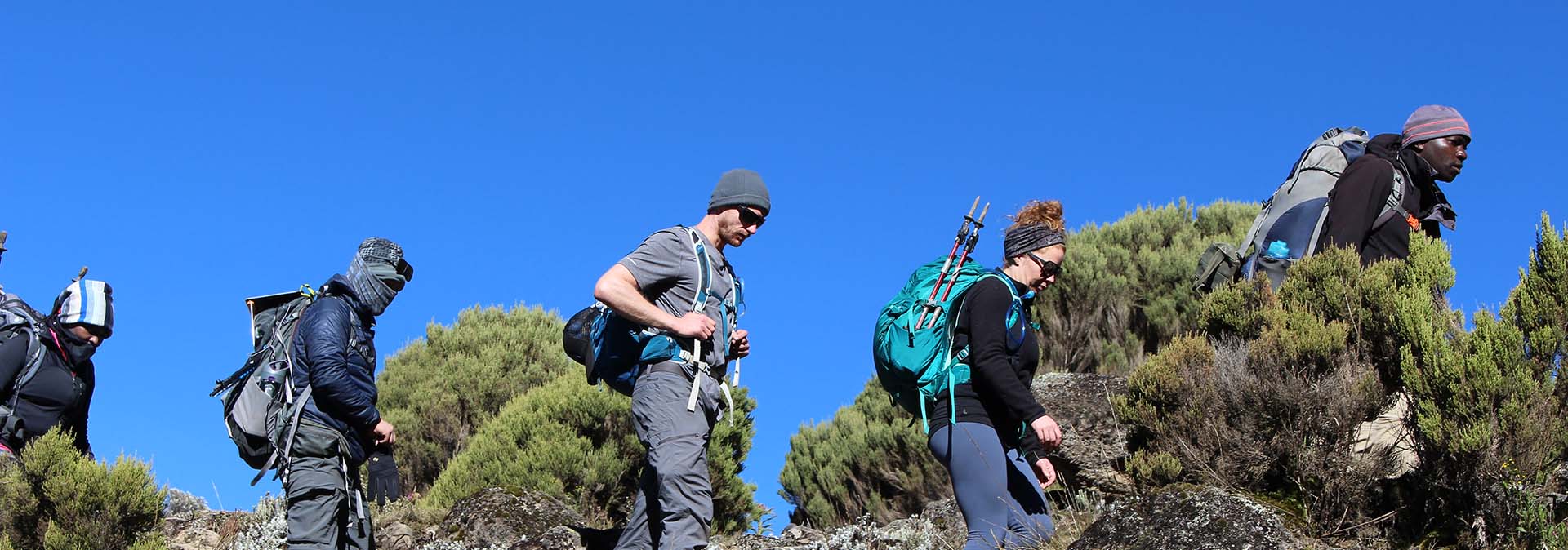
Tour Overview
The Rongai route is the only route that approaches Kilimanjaro from the north, close to the Kenyan border. Though gaining popularity amongst climbers, this route still experiences low crowds. Rongai has a more gradual slope than the mountain’s other routes. It is the preferred route for those looking for an alternative to the popular Marangu route, for those who would like a more remote hike, and for those who are climbing during the rainy season (the north side receives less precipitation). Rongai is a moderately difficult route, and is highly recommended, especially for those with less backpacking experience.
Although the scenery is not as varied as the western routes, Rongai makes up for this by passing through true wilderness areas for nearly the entire way. Descent is made via the Marangu route.
Day by Day Itinerary
Day 1: Rongai Gate (1,800m/5,900ft) to First Cave Camp (2,600m/8,400ft)
Elevation Gain: 800 metres / 2,500 feet
This morning you will drive for approximately 2 hours to the Rongai Gate near the Kenyan border. After registering at the gate, begin your climb to Uhuru Peak, the roof of Africa. During the first day, hike through forests where you may see and hear wildlife including Colobus Monkeys. Eat lunch on the trail before continuing to the first campsite. Rongai ascends via the less forested northern side of the mountain. The Rongai Route is one of the least crowded routes on Kilimanjaro and is thought to have the best chance of viewing wildlife.
Day 2: First Cave Camp (2,600m/8,400ft) to Kikelewa Camp (3,600m/11,800ft)
Elevation Gain: 1,000 metres / 3,400 feet
Day two takes you through Kilimanjaro’s moorland. During this day, view Mawenzi Peak ahead. The morning is steep and here you may begin to feel the altitude. You can stop to rest and explore at the first cave and lunch is often eaten close to the second cave. The afternoon is gentler as you contour across the moorland to camp in a sheltered valley at Kikelewa or the third cave. This is a long day with a trekking time of 6-7 hours.
Day 3: Kikelewa Camp (3,600m/11,800ft) to Mawenzi Tarn (4,330m/14,200ft)
Elevation Gain: 730 metres / 2,400 feet
This day is an acclimatisation day, allowing you to hike in the morning and rest in the afternoon and evening. The hike is relatively short but steep, but you are rewarded with superb all round views and a tangible sense of wilderness. Mawenzi Tarn campsite is situated below Mawenzi Peak and offers stunning views of both Mawenzi and Kibo.
Day 4: Acclimatisation Walk
Today you can have a lie in, as you will be staying at Mawenzi Tarn for a second night and therefore do not need to pack! The morning will be spent on an acclimatisation walk. Dependant upon how you are feeling this can be a steep walk up the scree slopes towards the peak of Mawenzi, or a gentler climb to the ridge or the lunar desert visiting the site of a plane crash. Return to Mawenzi Tarn for a hot lunch and afternoon of rest.
Day 5: Mawenzi Tarn Camp (4,330m/14,200ft) to Kibo Camp (4,700m/15,400ft)
Elevation Gain: 370 metres / 1,200 feet
Cross the lunar landscape of the saddle on this day to arrive at the high camp. Kibo Camp is situated directly below the summit cone, giving spectacular views over the Kenyan plains and Mawenzi and upwards to the climb that lies ahead. After lunch, spend your time resting in preparation for your summit attempt.
Day 6: Kibo Camp (4,700m/15,400ft) to Uhuru Peak (5,895m/19,340ft) to Horombo Hut (3,720m/12,200ft)
Elevation Gain: 1,195 metres / 3,940 feet
Elevation Loss: 2,175 metres / 7,140 feet
Around midnight, begin the final ascent to Uhuru Peak, the highest point in Africa. For the next six to eight hours, hike by the light of your flashlight. It can be very cold at night at these elevations, but it will be quite warm by the end of the hiking day and therefore you will want clothing for both extremes. The ascent to the crater rim is the most challenging part of the entire trek. The trail is very steep until you reach the crater rim at Gilman’s Point. The hike from Gilman’s to Uhuru Peak is a gradual climb and, as far as hikes go, not very difficult. The altitude however makes the hike long and tiring. After summit celebrations you will descend to Kibo Huts. You will eat here before continuing your descent to Horombo Huts. This will seem surprisingly fast. The total time spent walking on this day is around 14 hours, so be prepared for a very tough day. Later in the evening enjoy your last dinner on the mountain and a well-earned sleep.
Day 7: Horombo Hut (3,720m/12,200ft) to Marangu Gate (1,830m/6,000ft)
Elevation Loss: 1,890 metres / 6,200 feet
After breakfast, finish the trek with a descent to Marangu Gate. Your last hike on Kilimanjaro is a beautiful one, passing through Kilimanjaro’s cloud forest. Watch your step during the descent, as the trail can be slippery. This trek will take approximately 5-6 hours. At the gate, you will be met and transferred back to Moshi.
Prices Include:
Park fees, camping fees, rescue fees, head guide, assistant guides, cook, & porters salaries, all food, drinking water, tents & transport to/from park entry gate (ex Moshi).

